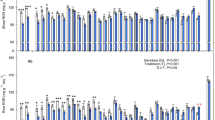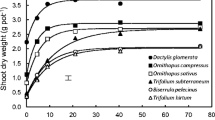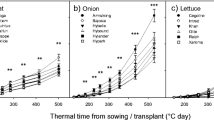Abstract
Perennial pastures are needed in farming systems in southern Australia to combat environmental problems such as dryland salinity. The mediterranean climate in southern Australia imposes constraints to the growth and survival of perennial plants. The aim of this study was to compare growth rates, resource allocation and root distribution in three perennial legumes, Medicago sativa L., Dorycnium hirsutum (L.) Ser. and Dorycnium rectum (L.) Ser., to identify different plant traits and their ecological and agronomic significance. Plants were grown in 1-m deep split tubes and destructive harvests were made every 2 weeks after plant emergence for 10 weeks. Leaf area and leaf, stem and root fresh and dry weights were measured. Maximum root depth and the root distribution were also determined. Seedlings of Dorycnium were slower to emerge and had a lower relative growth rate (RGR) than M. sativa. The slower RGR was associated with a lower specific leaf area (SLA) in D. hirsutum and a lower net assimilation rate (NAR) in D. rectum. Although all species allocated a similar proportion of biomass to roots, D. rectum had a shallower root distribution and took longer to produce deep roots. The slow growth rates of Dorycnium seedlings suggest that they are more prone to establishment problems due to competition from weeds or other pastures, and because they have less access to water at greater depth during summer drought. However, D. hirsutum displayed characteristics of a plant that is adapted to stressful environments and therefore may be able to grow in conditions where other perennial legumes cannot.
Similar content being viewed by others
References
J Ågren D Schemske (1993) ArticleTitleThe cost of defense against herbivores: An experimental study of trichome production in Brassica rapa Am Nat. 141 338–350 Occurrence Handle10.1086/285477
O N Allen E K Allen (1981) The Leguminosae. A source book of characteristics, uses and nodulation The University of Wisconsin Press Madison.
O K Atkin B Botman H Lambers (1996) ArticleTitleThe relationship between the relative growth rate and nitrogen economy of alpine and lowland Poa species Plant Cell Environ. 19 1324–1330
J C Avice A Ourry J J Volenec G Lemaire J Boucard (1996) ArticleTitleDefoliation-induced changes in abundance and immuno-localization of vegetative storage proteins in taproots of Medicago sativa Plant Physiol. Biochem. 34 561–571 Occurrence Handle1:CAS:528:DyaK28XltFOqsb0%3D
H G Baker (1972) ArticleTitleSeed weight in relation to environmental conditions in California Ecology 53 997–1010
M C Ball (1988) ArticleTitleSalinity tolerance in the mangroves Aegiceras corniculatum and Avicennia marina. I. Water use in relation to growth, carbon partitioning and salt balance Aust. J. Plant Physiol. 15 447–464
P S Cocks (2001) ArticleTitleEcology of herbaceous perennial legumes: a review of characteristics that may provide management options for the control of salinity and waterlogging in dryland cropping systems Aust. J. Agr. Res. 52 137–151 Occurrence Handle10.1071/AR99170
P D Coley J P Bryant F S I Chapin (1985) ArticleTitleResource availability and plant antiherbivory defence Science 230 895–899
C S Cooper (1977) ArticleTitleGrowth of the legume seedling Adv. Agron. 29 119–139
L Cransberg D J McFarlane (1994) ArticleTitleCan perennial pastures provide the basis for a sustainable farming system in southern Australia? New Zeal. J. Agr. Res. 37 287–294
B S Dear G A Moore S J Hughes (2003) ArticleTitleAdaptation and potential contribution of temperate perennial legumes to the southern Australian wheatbelt: a review Aust. J. Exp. Agr. 43 1–18 Occurrence Handle10.1071/EA01202
G B Douglas A G Foote (1994) ArticleTitleEstablishment of perennial species useful for soil conservation and as forages New Zeal. J. Agr. Res. 37 1–9
J Ehleringer (1984) Ecology and ecophysiology of leaf pubescence in North American desert plants E Rodrigues P L Healey I Mehta (Eds) Biology and Chemistry of Plant Trichomes Plenum New York 113–132
C O Elias D R Causton (1975) ArticleTitleTemperature and the growth of Impatiens parviflora DC New Phytol. 75 495–505
G C Evans (1972) The quantitative analysis of plant growth Blackwell Scientific Publications Oxford, England
M A Ewing P J Dolling (2003) Herbaceous perennial pasture legumes: Their role and development in southern Australian farming systems to enhance system stability and profitability S J Bennett (Eds) New perennial legumes for sustainable agriculture University of Western Australia Press Perth, Western Australia 3–14
M Fenner (1983) ArticleTitleRelationships between seed weight, ash content and seedling growth in twenty-four species of Compositae New Phytol. 95 697–706
GenStat 6 Committee 2002 ‘GenStat 6th Edition v 6.1.0.200’ Lawes Agricultural Trust, UK
G Grammatikopoulous Y Manetas (1994) ArticleTitleDirect absorption of water by hairy leaves of Pholomis fruticosa and its contribution to drought avoidance Can. J. Bot. 72 1805–1811
J P Grime R Hunt (1975) ArticleTitleRelative growth rate: Its range and adaptive significance in a local flora J. Ecol. 53 393–422
K L Gross (1984) ArticleTitleEffect of seed size and growth form on seedling establishment on six monocarpic perennial plants J. Ecol. 72 369–387
A W Humphries G C Auricht (2001) ArticleTitleBreeding lucerne for Australia’s southern dryland cropping environments Aust. J. Agr. Res. 52 153–169 Occurrence Handle10.1071/AR99171
G Karabourniotis D Kotsabassidis Y Manetas (1995) ArticleTitleTrichome density and its protective potential against ultra-violet-B radiation damage during leaf development Can. J. Bot. 73 376–383
H Lambers H Poorter (1992) ArticleTitleInherent variation in growth rate between higher plants: A search for physiological causes and ecological consequences Adv. Ecol. Res. 23 187–261 Occurrence Handle1:CAS:528:DyaK3sXksVGiu7w%3D
K H Northcote (1971) A factual key for the recognition of Australian soils Rellim Glenside, South Australia
H Poorter C Remkes (1990) ArticleTitleLeaf area ratio and net assimilation rate of 24 wild species differing in relative growth rate Oecologia 83 553–559
H Poorter D C Vander Werf (1998) Is inherent variation in RGR determined by LAR at low irradiance and by NAR at high irradiance? A review of herbaceous species H Lambers H Poorter M Van Vuuren (Eds) Inherent variation in plant growth. Physiological mechanisms and ecological consequences Backhuys Publishers Leiden 309–336
M Qifu N Longnecker C Atkins (2002) ArticleTitleVarying phosphorus supply and development, growth and seed yield in narrow-leafed lupin Plant Soil 239 79–85
N A M G Rozijn D C Vander Werf (1986) ArticleTitleEffect of drought during different stages in the life cycle on the growth and biomass of two Aira species J. Ecol. 74 507–523
J S Sheppard G B Douglas (1984) ArticleTitleCanary clovers Streamland 32 4–8
J S Sheppard G B Douglas (1986) ArticleTitleManagement and uses of Dorycnium spp Water Soil Miscell. Publ. 94 260–262
E Small (2003) Distribution of perennial Medicago with particular reference to agronomic potential for semi-arid Mediterranean climate S J Bennett (Eds) New Perennial Legumes for Sustainable Agriculture University of Western Australia Press Perth, Western Australia 57–80
H M Taylor B Keppler (1978) ArticleTitleThe role of rooting characteristics in the supply of water to plants Adv. Agron. 30 99
T H Terrill A M Rowan G D Douglas T N Barry (1992) ArticleTitleDetermination of extractable and bound condensed tannin concentrations in forage plants, protein concentrate meals and cereal grains J. Sci. Food Agr. 58 321–329 Occurrence Handle1:CAS:528:DyaK38XksVKrtro%3D
J C Venus D R Causton (1979) ArticleTitlePlant growth analysis: A re-examination of the methods of calculation of relative growth and net assimilation rates without using fitted functions Ann. Bot. 43 633–638
Waghorn GC, Douglas GB, Niezen JH, McNabb WC, Foote AG 1998 Forages with condensed tannins – their management and nutritive value for ruminants. In: New Zealand Grassland Association pp. 89–98
B J Wills (1984) ArticleTitleAlternative plant species for revegetation and soil conservation in the tussock grasslands of New Zealand Tussock Grassl Mountain Lands Instit. Rev. 42 49–58
Wills B J, Begg J S C, Foote A G 1989a Dorycnium species - Two new legumes with potential for dryland pasture rejuvenation and resource conservation in New Zealand. In: New Zealand Grassland Association, pp. 169–174
Wills B J, Begg J S C, Sheppard J S S 1989b Dorycnium and other Mediterranean species – their use for forage and soil conservation in semi-arid environments in New Zealand. In: XVI International Grassland Congress, Nice, France, 4–11 October 1989: pp. 1517
B J Wills G B Douglas A G Foote K D Trainor (1999) ArticleTitleGermplasm characterization and palatability of Dorycnium species under New Zealand dryland conditions Plant Gen. Resour. Newslett. 120 8–14
B J Wills K D Trainor R P Littlejohn (2004) ArticleTitleSemiarid land rehabilitation by direct drilling in the South Island, New Zealand – Plant species and establishment technology Land Degrad. Develop. 15 1–14
Author information
Authors and Affiliations
Corresponding author
Rights and permissions
About this article
Cite this article
Bell, L.W. Relative growth rate, resource allocation and root morphology in the perennial legumes, Medicago sativa, Dorycnium rectum and D. hirsutum grown under controlled conditions. Plant Soil 270, 199–211 (2005). https://doi.org/10.1007/s11104-004-1495-6
Received:
Accepted:
Issue Date:
DOI: https://doi.org/10.1007/s11104-004-1495-6




